Yonggen Ling
VinT-6D: A Large-Scale Object-in-hand Dataset from Vision, Touch and Proprioception
Jan 06, 2025



Abstract:This paper addresses the scarcity of large-scale datasets for accurate object-in-hand pose estimation, which is crucial for robotic in-hand manipulation within the ``Perception-Planning-Control" paradigm. Specifically, we introduce VinT-6D, the first extensive multi-modal dataset integrating vision, touch, and proprioception, to enhance robotic manipulation. VinT-6D comprises 2 million VinT-Sim and 0.1 million VinT-Real splits, collected via simulations in MuJoCo and Blender and a custom-designed real-world platform. This dataset is tailored for robotic hands, offering models with whole-hand tactile perception and high-quality, well-aligned data. To the best of our knowledge, the VinT-Real is the largest considering the collection difficulties in the real-world environment so that it can bridge the gap of simulation to real compared to the previous works. Built upon VinT-6D, we present a benchmark method that shows significant improvements in performance by fusing multi-modal information. The project is available at https://VinT-6D.github.io/.
Constraint-Aware Zero-Shot Vision-Language Navigation in Continuous Environments
Dec 13, 2024Abstract:We address the task of Vision-Language Navigation in Continuous Environments (VLN-CE) under the zero-shot setting. Zero-shot VLN-CE is particularly challenging due to the absence of expert demonstrations for training and minimal environment structural prior to guide navigation. To confront these challenges, we propose a Constraint-Aware Navigator (CA-Nav), which reframes zero-shot VLN-CE as a sequential, constraint-aware sub-instruction completion process. CA-Nav continuously translates sub-instructions into navigation plans using two core modules: the Constraint-Aware Sub-instruction Manager (CSM) and the Constraint-Aware Value Mapper (CVM). CSM defines the completion criteria for decomposed sub-instructions as constraints and tracks navigation progress by switching sub-instructions in a constraint-aware manner. CVM, guided by CSM's constraints, generates a value map on the fly and refines it using superpixel clustering to improve navigation stability. CA-Nav achieves the state-of-the-art performance on two VLN-CE benchmarks, surpassing the previous best method by 12 percent and 13 percent in Success Rate on the validation unseen splits of R2R-CE and RxR-CE, respectively. Moreover, CA-Nav demonstrates its effectiveness in real-world robot deployments across various indoor scenes and instructions.
Category-level Object Detection, Pose Estimation and Reconstruction from Stereo Images
Jul 09, 2024Abstract:We study the 3D object understanding task for manipulating everyday objects with different material properties (diffuse, specular, transparent and mixed). Existing monocular and RGB-D methods suffer from scale ambiguity due to missing or imprecise depth measurements. We present CODERS, a one-stage approach for Category-level Object Detection, pose Estimation and Reconstruction from Stereo images. The base of our pipeline is an implicit stereo matching module that combines stereo image features with 3D position information. Concatenating this presented module and the following transform-decoder architecture leads to end-to-end learning of multiple tasks required by robot manipulation. Our approach significantly outperforms all competing methods in the public TOD dataset. Furthermore, trained on simulated data, CODERS generalize well to unseen category-level object instances in real-world robot manipulation experiments. Our dataset, code, and demos will be available on our project page.
Mx2M: Masked Cross-Modality Modeling in Domain Adaptation for 3D Semantic Segmentation
Jul 09, 2023Abstract:Existing methods of cross-modal domain adaptation for 3D semantic segmentation predict results only via 2D-3D complementarity that is obtained by cross-modal feature matching. However, as lacking supervision in the target domain, the complementarity is not always reliable. The results are not ideal when the domain gap is large. To solve the problem of lacking supervision, we introduce masked modeling into this task and propose a method Mx2M, which utilizes masked cross-modality modeling to reduce the large domain gap. Our Mx2M contains two components. One is the core solution, cross-modal removal and prediction (xMRP), which makes the Mx2M adapt to various scenarios and provides cross-modal self-supervision. The other is a new way of cross-modal feature matching, the dynamic cross-modal filter (DxMF) that ensures the whole method dynamically uses more suitable 2D-3D complementarity. Evaluation of the Mx2M on three DA scenarios, including Day/Night, USA/Singapore, and A2D2/SemanticKITTI, brings large improvements over previous methods on many metrics.
A Miniaturised Camera-based Multi-Modal Tactile Sensor
Mar 06, 2023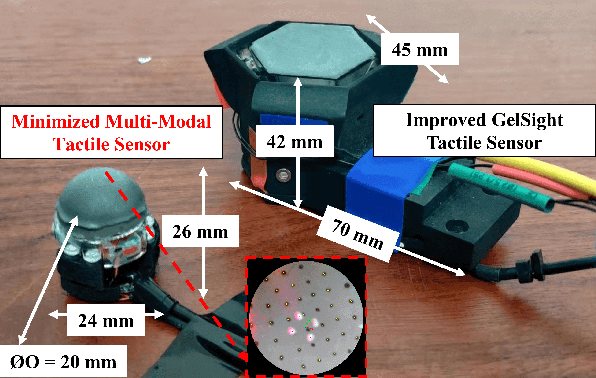

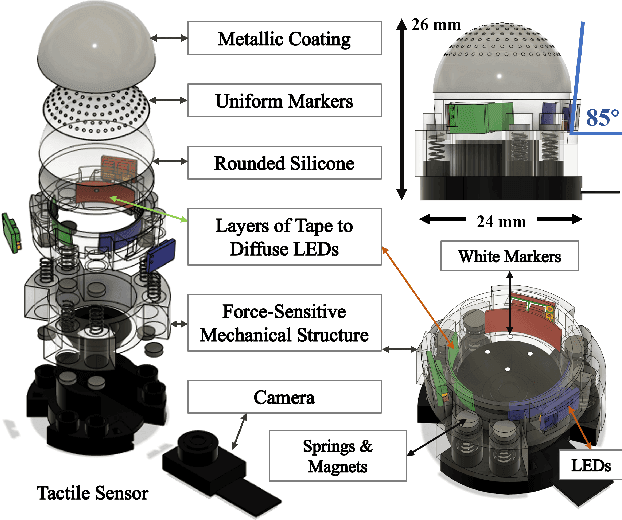
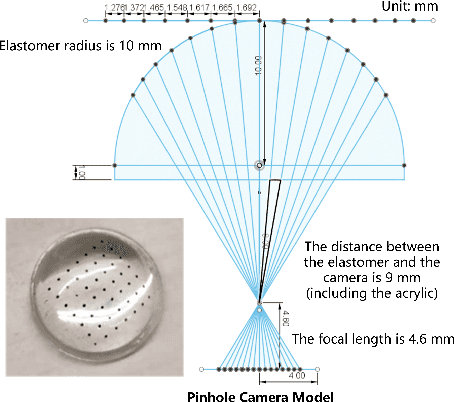
Abstract:In conjunction with huge recent progress in camera and computer vision technology, camera-based sensors have increasingly shown considerable promise in relation to tactile sensing. In comparison to competing technologies (be they resistive, capacitive or magnetic based), they offer super-high-resolution, while suffering from fewer wiring problems. The human tactile system is composed of various types of mechanoreceptors, each able to perceive and process distinct information such as force, pressure, texture, etc. Camera-based tactile sensors such as GelSight mainly focus on high-resolution geometric sensing on a flat surface, and their force measurement capabilities are limited by the hysteresis and non-linearity of the silicone material. In this paper, we present a miniaturised dome-shaped camera-based tactile sensor that allows accurate force and tactile sensing in a single coherent system. The key novelty of the sensor design is as follows. First, we demonstrate how to build a smooth silicone hemispheric sensing medium with uniform markers on its curved surface. Second, we enhance the illumination of the rounded silicone with diffused LEDs. Third, we construct a force-sensitive mechanical structure in a compact form factor with usage of springs to accurately perceive forces. Our multi-modal sensor is able to acquire tactile information from multi-axis forces, local force distribution, and contact geometry, all in real-time. We apply an end-to-end deep learning method to process all the information.
HVC-Net: Unifying Homography, Visibility, and Confidence Learning for Planar Object Tracking
Sep 19, 2022
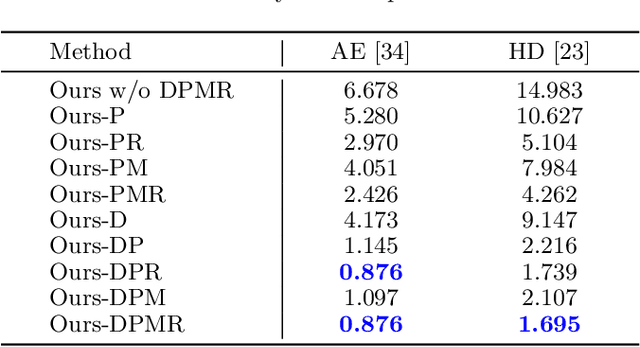


Abstract:Robust and accurate planar tracking over a whole video sequence is vitally important for many vision applications. The key to planar object tracking is to find object correspondences, modeled by homography, between the reference image and the tracked image. Existing methods tend to obtain wrong correspondences with changing appearance variations, camera-object relative motions and occlusions. To alleviate this problem, we present a unified convolutional neural network (CNN) model that jointly considers homography, visibility, and confidence. First, we introduce correlation blocks that explicitly account for the local appearance changes and camera-object relative motions as the base of our model. Second, we jointly learn the homography and visibility that links camera-object relative motions with occlusions. Third, we propose a confidence module that actively monitors the estimation quality from the pixel correlation distributions obtained in correlation blocks. All these modules are plugged into a Lucas-Kanade (LK) tracking pipeline to obtain both accurate and robust planar object tracking. Our approach outperforms the state-of-the-art methods on public POT and TMT datasets. Its superior performance is also verified on a real-world application, synthesizing high-quality in-video advertisements.
Domain Adaptation Gaze Estimation by Embedding with Prediction Consistency
Nov 15, 2020
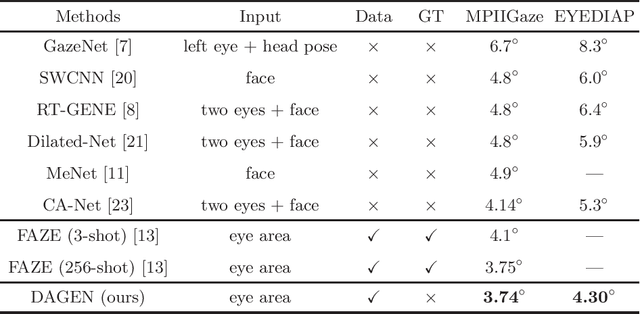
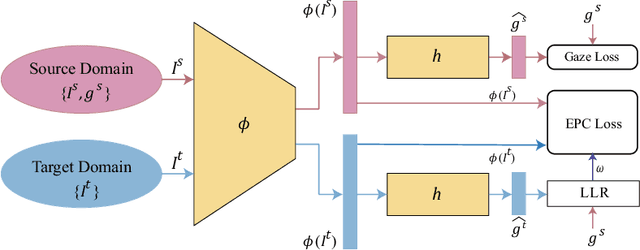

Abstract:Gaze is the essential manifestation of human attention. In recent years, a series of work has achieved high accuracy in gaze estimation. However, the inter-personal difference limits the reduction of the subject-independent gaze estimation error. This paper proposes an unsupervised method for domain adaptation gaze estimation to eliminate the impact of inter-personal diversity. In domain adaption, we design an embedding representation with prediction consistency to ensure that the linear relationship between gaze directions in different domains remains consistent on gaze space and embedding space. Specifically, we employ source gaze to form a locally linear representation in the gaze space for each target domain prediction. Then the same linear combinations are applied in the embedding space to generate hypothesis embedding for the target domain sample, remaining prediction consistency. The deviation between the target and source domain is reduced by approximating the predicted and hypothesis embedding for the target domain sample. Guided by the proposed strategy, we design Domain Adaptation Gaze Estimation Network(DAGEN), which learns embedding with prediction consistency and achieves state-of-the-art results on both the MPIIGaze and the EYEDIAP datasets.
Learning End-to-End Action Interaction by Paired-Embedding Data Augmentation
Jul 16, 2020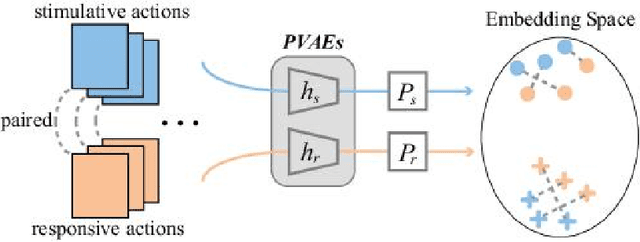

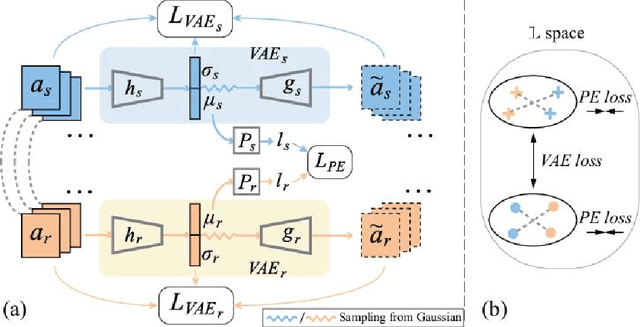

Abstract:In recognition-based action interaction, robots' responses to human actions are often pre-designed according to recognized categories and thus stiff. In this paper, we specify a new Interactive Action Translation (IAT) task which aims to learn end-to-end action interaction from unlabeled interactive pairs, removing explicit action recognition. To enable learning on small-scale data, we propose a Paired-Embedding (PE) method for effective and reliable data augmentation. Specifically, our method first utilizes paired relationships to cluster individual actions in an embedding space. Then two actions originally paired can be replaced with other actions in their respective neighborhood, assembling into new pairs. An Act2Act network based on conditional GAN follows to learn from augmented data. Besides, IAT-test and IAT-train scores are specifically proposed for evaluating methods on our task. Experimental results on two datasets show impressive effects and broad application prospects of our method.
Attention-Oriented Action Recognition for Real-Time Human-Robot Interaction
Jul 02, 2020
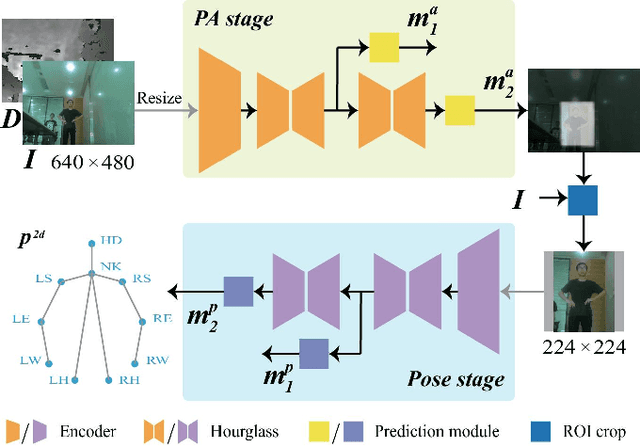
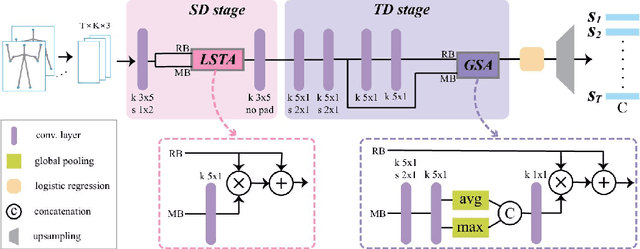
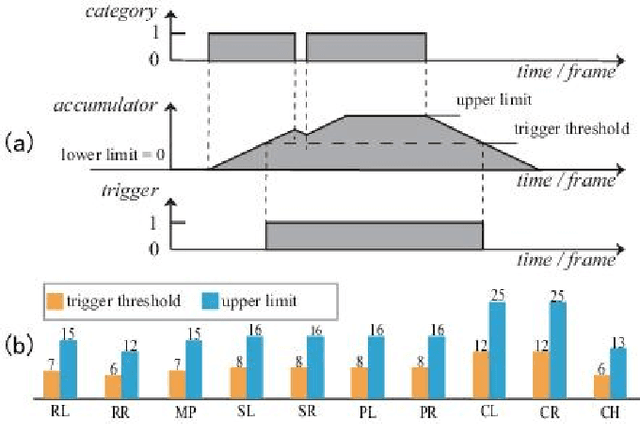
Abstract:Despite the notable progress made in action recognition tasks, not much work has been done in action recognition specifically for human-robot interaction. In this paper, we deeply explore the characteristics of the action recognition task in interaction scenarios and propose an attention-oriented multi-level network framework to meet the need for real-time interaction. Specifically, a Pre-Attention network is employed to roughly focus on the interactor in the scene at low resolution firstly and then perform fine-grained pose estimation at high resolution. The other compact CNN receives the extracted skeleton sequence as input for action recognition, utilizing attention-like mechanisms to capture local spatial-temporal patterns and global semantic information effectively. To evaluate our approach, we construct a new action dataset specially for the recognition task in interaction scenarios. Experimental results on our dataset and high efficiency (112 fps at 640 x 480 RGBD) on the mobile computing platform (Nvidia Jetson AGX Xavier) demonstrate excellent applicability of our method on action recognition in real-time human-robot interaction.
Self-supervised Learning of Detailed 3D Face Reconstruction
Oct 25, 2019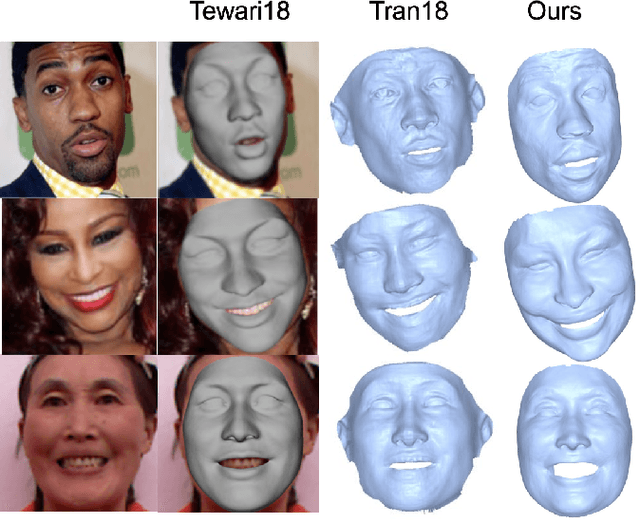
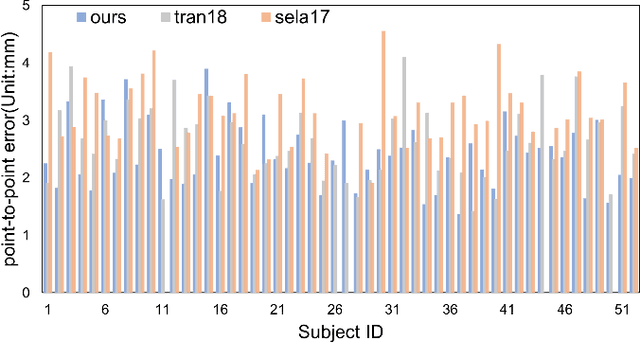
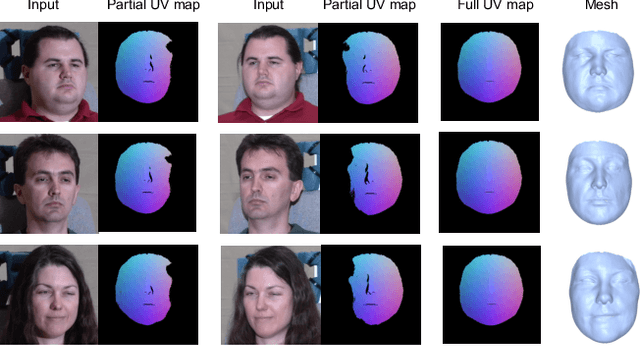
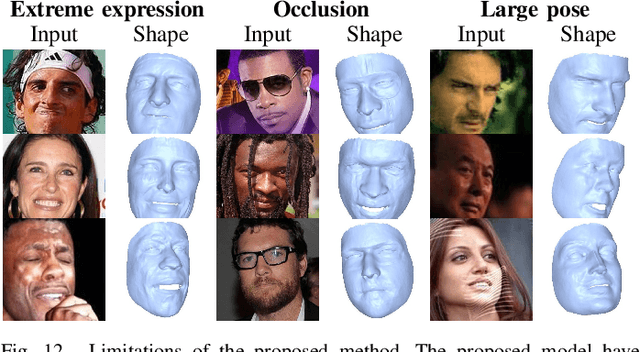
Abstract:In this paper, we present an end-to-end learning framework for detailed 3D face reconstruction from a single image. Our approach uses a 3DMM-based coarse model and a displacement map in UV-space to represent a 3D face. Unlike previous work addressing the problem, our learning framework does not require supervision of surrogate ground-truth 3D models computed with traditional approaches. Instead, we utilize the input image itself as supervision during learning. In the first stage, we combine a photometric loss and a facial perceptual loss between the input face and the rendered face, to regress a 3DMM-based coarse model. In the second stage, both the input image and the regressed texture of the coarse model are unwrapped into UV-space, and then sent through an image-toimage translation network to predict a displacement map in UVspace. The displacement map and the coarse model are used to render a final detailed face, which again can be compared with the original input image to serve as a photometric loss for the second stage. The advantage of learning displacement map in UV-space is that face alignment can be explicitly done during the unwrapping, thus facial details are easier to learn from large amount of data. Extensive experiments demonstrate the superiority of the proposed method over previous work.
 Add to Chrome
Add to Chrome Add to Firefox
Add to Firefox Add to Edge
Add to Edge